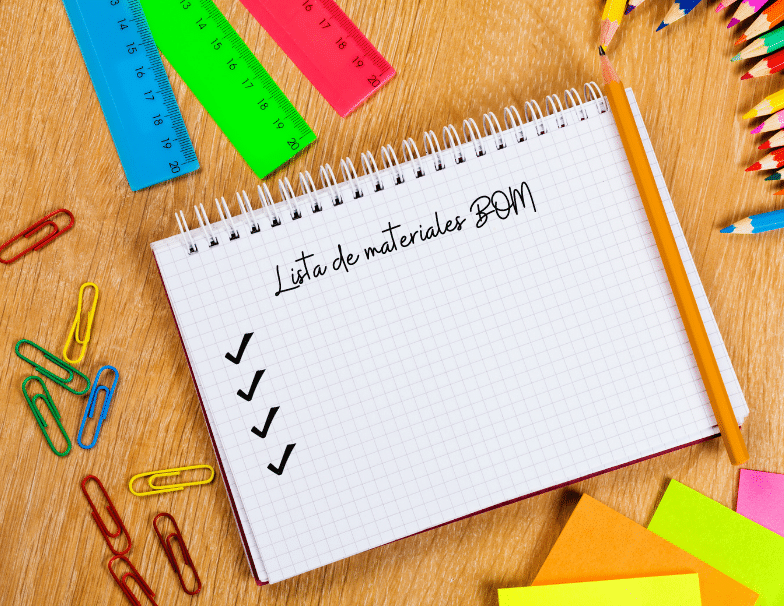If we talk about bread making, the list of materials would include flour, yeast and water, as well as the infrastructure, kneading machines, ovens and the exact instructions of the production process.
Have you ever heard of the concept of BOM of materials? This bill of materials serves to reduce costs in warehouse operations and has a direct impact on the correct supply of production lines. In the end, it is the first step towards an optimised, error-free production line that works at full capacity.
What is a BOM of materials?
The Bill of Materials (BOM) is a document that defines all the indispensable elements in a production process. As a general rule, this list influences the design, production and assembly stages of a product, and lists the raw materials, parts, tools, components and sub-components that can make up a product.
Benefits of a correct BOM
A defined, detailed and complete BOM helps companies at different stages of production, from functional design within product development to product launch. These aids companies are based on:
1. Plan the purchase of raw materials
It is pointed out which raw materials have to be purchased and in what quantity to produce a product. This reduces costs and avoids overstocking of raw materials.
2. Establish the cost of material
Not only the raw material costs, but also the equipment has to be taken into account.
3. Avoid stock-outs
Sufficient raw material must be available to manufacture a product uninterruptedly and in accordance with the needs of the consumer and customer.
4. Detect and minimise errors
Anticipating and following instructions at each step reduces the probability of making mistakes and it is easier to detect where and when there has been an incident.
5. Gain inventory control and keep accurate records
Knowing what we purchase, have and need is relevant to the production of any product, as well as keeping accurate records of material used and purchased.
6. Ensuring robustness of supply and reducing downtime
Not paralysing production due to lack of materials is a point to bear in mind, as it depends on us and our foresight.
Designing and creating a clear and concise
Clear and concise. This is what a bill of materials or BOM should look like and, in its hierarchical structure, the highest level should show the finished product and the lower levels the components and sub-components. But there are two types of BOM structures depending on the complexity of the product:
- Single-level bill of materials: unspecific bill of materials. It shows the components and the quantity required to manufacture the final product. An example would be the bill of materials of a table.
- Multilevel bill of materials: it lists several levels with components and sub-components, as well as the relationship between them and their quantity. An example would be the BOM of a bicycle.
Similarly, the bill of materials can contain additional specifications such as level, identification number, description, quantity or notes.
In the end, it is important that the client and the company know the limitations of the idea with regard to volume, weight, energy required, running times, minimum viable product and the amount of material used. At this point, the Infinita team can intervene to strategically design a prototyping plan and a BOM list that foresees the possible needs to achieve the desired final product.
In short, if each aspect, phase and material for the production of a product is known and planned in a structured way, the result can be very satisfactory from all points of view.
BOM types or bill of materials
- MBOM / manufacturing: includes information on all the parts and assemblies required to build and ship a product to the customer. It is used to calculate when materials must be purchased and to determine the order of production.
- EBOM / engineering: This is created during the design phase and refers to the finished product. It is, however, essential for the launch of a new product because it ensures that materials and parts are available.
- SBOM / Sales: identifies installation and repair steps, as well as repairable components that a service technician should be aware of.
- Sales Bill Of Materials: The finished product and components are listed as separate items on the sales order document.
Bill of Materials are neither exclusive nor independent, so it is possible that more than one BOM may be developed for an activity.
How can I create a BOM?
Infinitia’s technical team can help you choose the right BOM model for the production and creation of a new product in your company. In the end, at Infinita we combine different product developments from the ideation stages to the realisation or design of prototypes.
We do not forget our customers because without them product development would be meaningless. We offer you a global solution in product quality, taking into account technology, innovation, design, materials and all stages of manufacturing.
And, of course, we make your ideas come true and you have everything you need to achieve a result in accordance with your needs and objectives, as happened with the redesign of plastic components for their manufacture and industrialisation, where the Product Development team took into account all the elements and components to carry it out. Contact us and we will study the best solution and fine-tuning.





